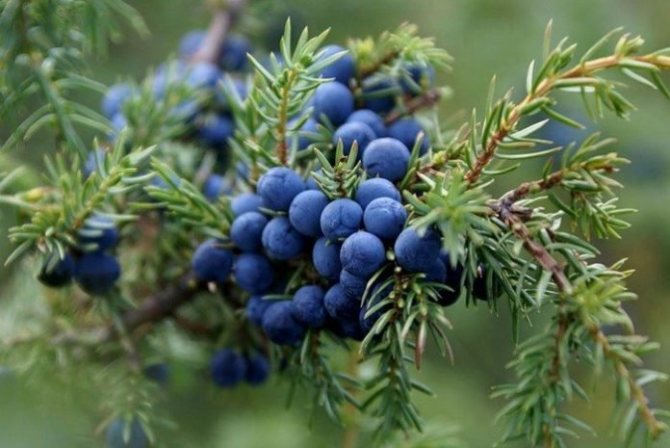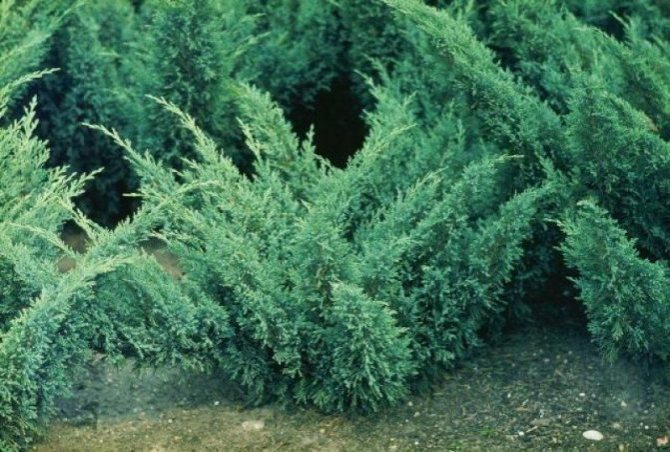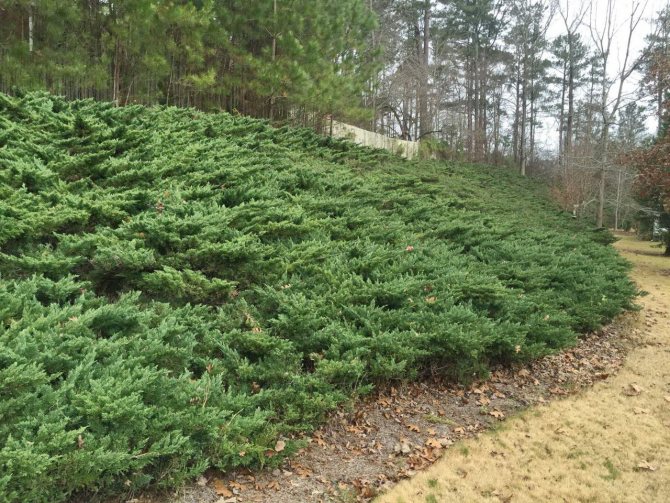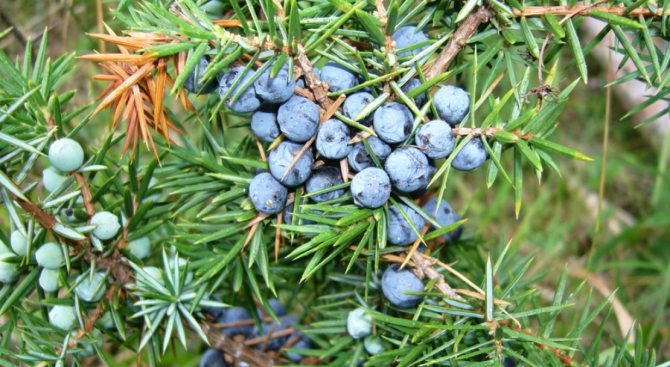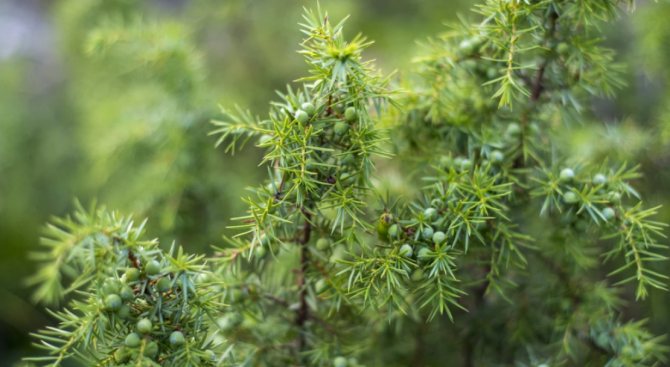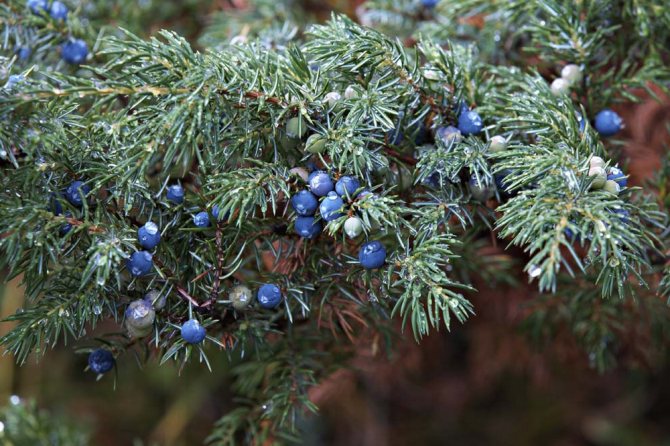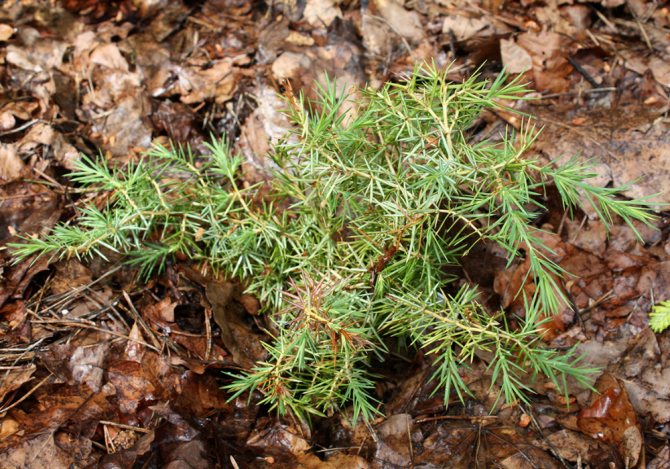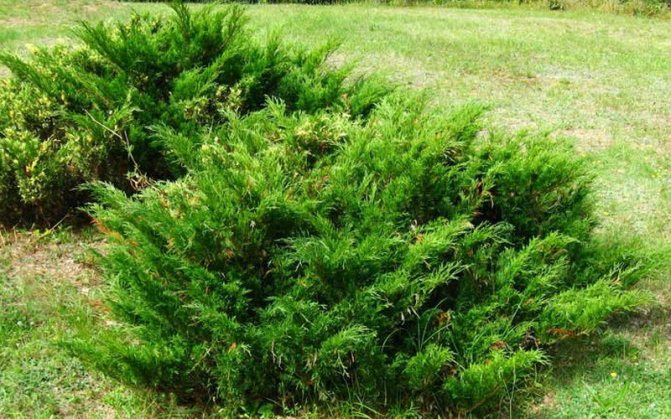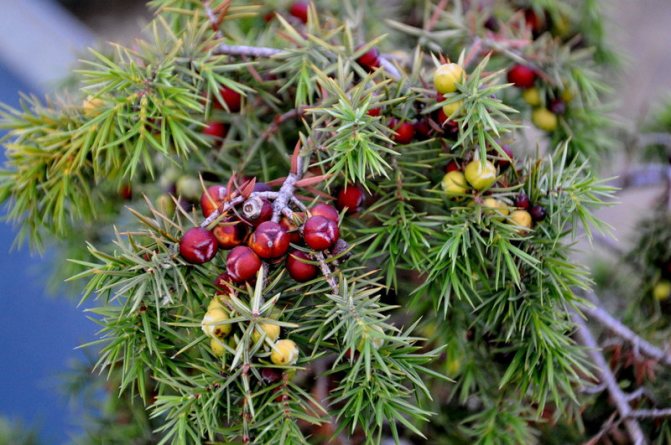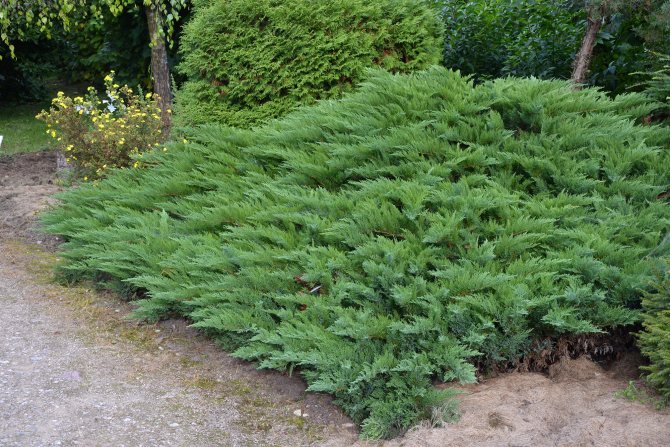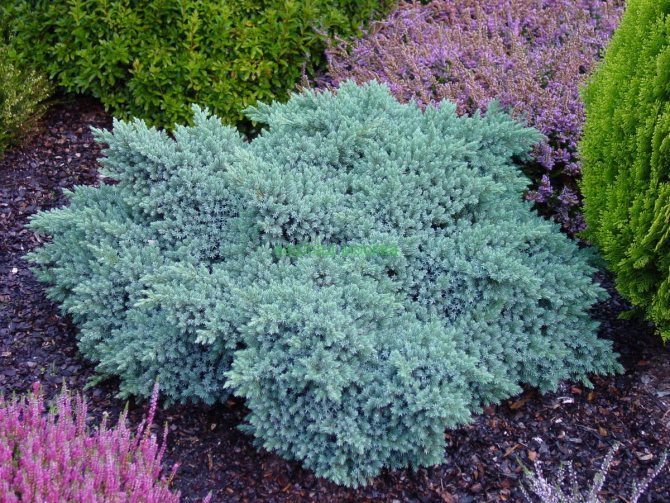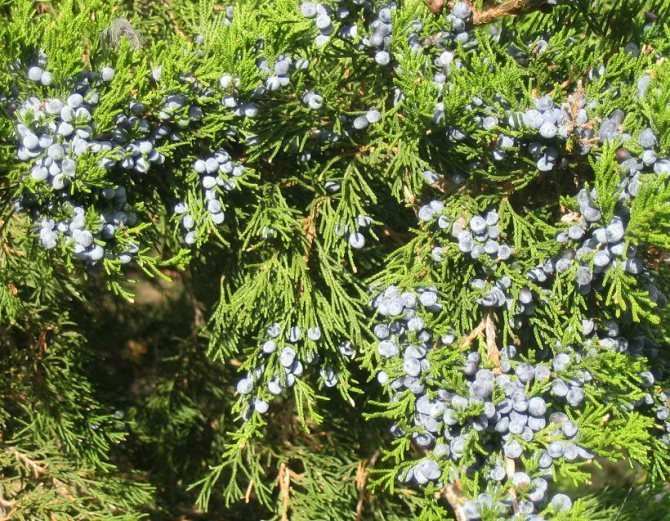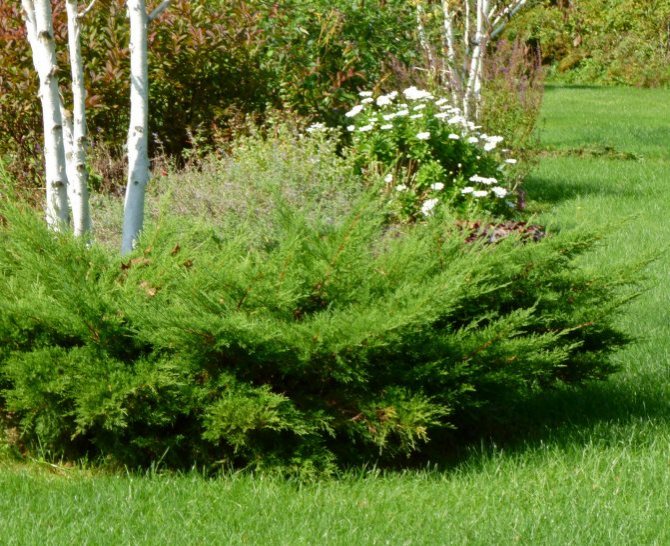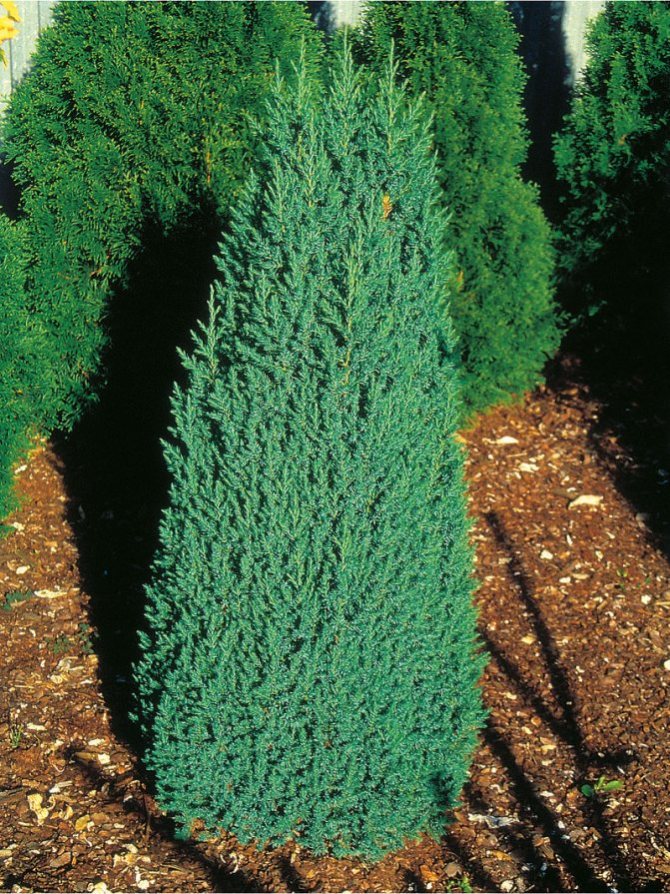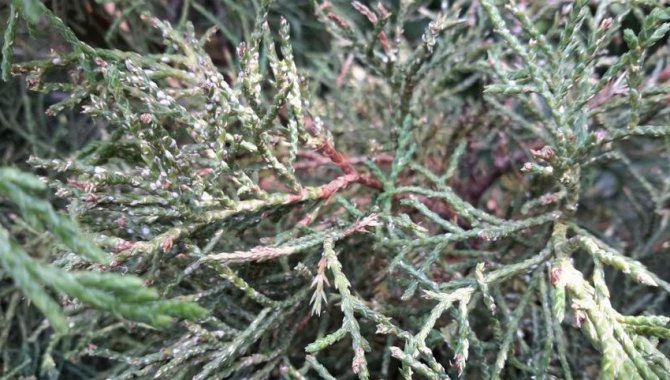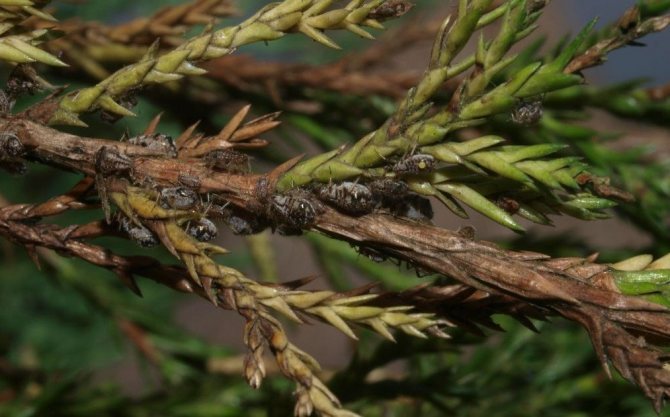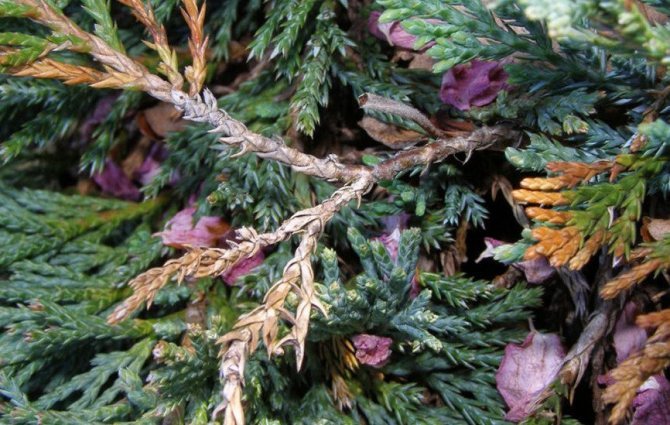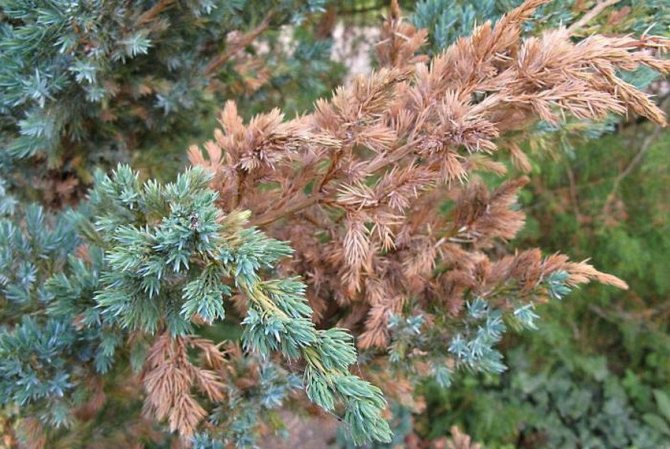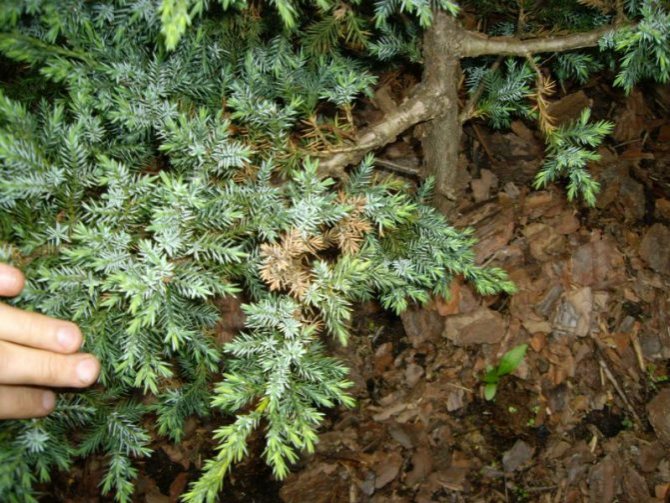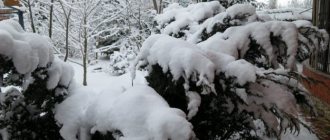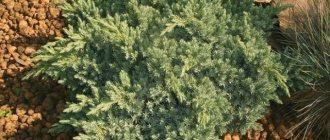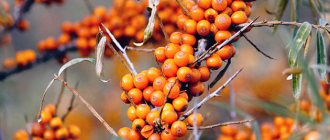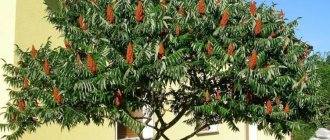Juniper (Juniperus) botanists attributed to the genus of evergreen conifers, which have a shrub or tree-like form of life, and are part of the Cypress family (Cupressaceae). Almost all representatives of the genus are distributed in the Northern Hemisphere, from the Arctic lands to mountainous regions with a subtropical climate, with the exception of only the East African juniper (Juniperus procera), which can be found on the African continent up to 18 degrees south latitude. And only common juniper occupies rather large growing areas, but the rest differ in that their ranges are rather limited, for example, only in mountainous areas. A variety of common juniper is also known under the name Veres, and the Turkic peoples also have a name for tree-like representatives, which was included in scientific works as "archa". The Latin name (according to one version) comes from joini-parus, which means "giving branches suitable for weaving", but there is other information that the term Juneprus will be translated as "prickly", all due to the fact that the leaves of some plant species have a prickly outline.
Juniper is tree-shaped, large in size, with a height of 10–20 m. Other varieties of this plant can take the form of smaller trees or tall shrubs that inhabit deciduous or coniferous forests. There are also junipers in the genus that are undersized or even with creeping shoots, which do well on rocky slopes and rocky surfaces that are located at the upper border of forests. The height of the juniper begins with half a meter.
The buds of the plant are bare, devoid of scales, occasionally they are surrounded by pressed rather short leaves, and only the variety of drupe juniper (Juniperus drupaceae) has a large number of dense scales. The leaves are collected in whorls of three units, their outlines are acicular and scaly, they grow apart, linear-lanceolate. At the base, the leaf is escaping, and in its upper part there is an stomatal strip, and there is also a median longitudinal vein, which takes on an undivided or divided form. When the plant is young, then its foliage has the shape of needles, over time, the leaves of the juniper resemble small scales that grow, clinging to the shoots. Their location is sometimes in three-membered whorls or they grow in pairs opposite.
The plant is dioecious. Male flowers have the appearance of spikelets or earrings; they can grow either singly or in several pieces. Location on last year's or lateral shoots in leaf axils. Scale-like stamens (3-4 pieces), connected in pairs opposite or in whorls of three pieces. Each of the stamens has 3–6 anther opening longitudinally. Female flowers, crowned with shortened twigs, or grow finite, taking the shape of cones. The flowering process occurs in June.
When fruiting, a cone with the shape of a berry ripens, it is called so a cone berry. This fruit does not open, its scales are fleshy and tightly closed, the shape is spherical or with a slight elongation. Inside contains 1–10 seeds, which grow separately, and in stone juniper - with intergrowth.Full ripening of the lump takes place in the second year from its formation. The plant bears fruit only from August to September.
Other names for common juniper
The considered vegetation in ancient times had several different names. They differed depending on the region of growth.
Did you know? Thickets of juniper bushes are often formed where there are coal deposits, which geologists are actively using for their own purposes. For example, it was thanks to this feature that the Moscow Region coal basin was opened.
The most commonly used names are:
- heather;
- yalovets;
- walrus;
- bruzewelnik;
- juniper.
The most popular of all the names that have survived to this day is juniper. According to some reports, it comes from the combination of the words "between spruces", since this vegetation was most often found as undergrowth in spruce tracts.
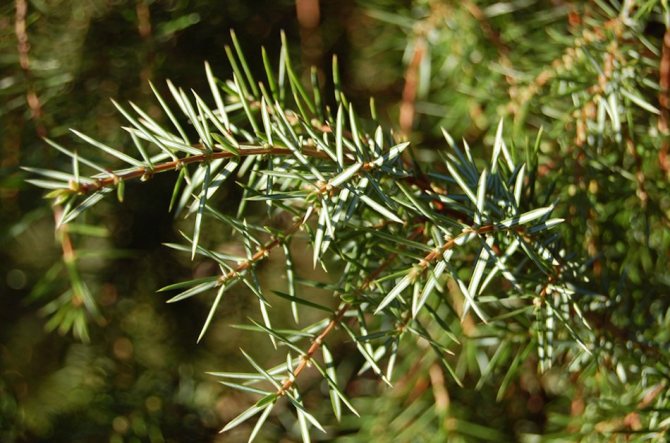
According to another version, the name originates from the Old Slavic word "mozhzha", which means "knot" in translation. This is due to the external data of the plant - on the branches of old specimens, seals resembling knots are visible in the places of shoot growth.
Reproduction
Juniper grows in traditional varieties: seeds, layering and cuttings. The last method - cuttings - is especially productive. The rooting rate is established by the type of culture, the time period of cuttings and the type of cuttings. Common juniper and Cossack juniper take root best of all (70–90%). Cuttings are allowed throughout the year, but the best time is spring.
At first, they are rooted in a greenhouse, after (in late spring or in June) - in a bed under a film cover, and in winter (February-March) - in a greenhouse. Cut cuttings should be held a little in water or in a wet burlap.
The best circumstances for excellent adaptability of cuttings are:
- temperature 16-19 C before bud flowering and 23-26 C after;
- wet base and systematic spraying;
- diffused light.
- Pay attention to one peculiarity:
The spreading cuttings are rooted obliquely, and the columnar cuttings are rooted vertically. Only spreading species of juniper reproduce by layering during the growing season. For example, columnar forms have spreading layers.
Botanical description
The appearance of a juniper depends on several factors.
The main ones are:
- varietal affiliation;
- place of growth;
- climate.
However, all varieties have a number of characteristics, on the basis of which a general description can be drawn. Using this information, you can easily distinguish junipers from other plants.
Check out the Andorra Variegata juniper.
Juniper characteristic:
- attitude to light - light-loving, drought-resistant;
- acceptable temperature conditions - –30 ... + 40 ° С;
- methods of reproduction - by seeds, cuttings, layering.
Family and genus of juniper
Vegetation represents the genus Juniper, the Cypress family. In Latin, the juniper will be called Juniperus communis. The first descriptions of it are found in ancient Greek treatises and myths. At that time, its cultivation was practiced to produce medicines. Today, a total of over 70 wild and ornamental species are known.
Shrub or tree, coniferous or deciduous
Juniper is a coniferous evergreen plant. Both shrub and woody forms are found in nature. It all depends on the zone in which the heather will grow. In the northern latitudes, the vegetation is a shrub, in the southern - a tree. The crown is conical or ovoid, sometimes with drooping shoots at the ends. Bushes can be standing or creeping. The juniper leaf is called a needle or flake.
Learn how to treat juniper rust.
But these are precisely the leaves that have an elongated-lanceolate shape, and not needles, like in other conifers. The common juniper has needle-like leaf plates. They are triangular, with a rigid structure. They reach 1.5 cm in length and 1 mm in width. Covered with a layer of wax coating: it is he who gives various shades to the sheet plates - light green, bluish or golden.
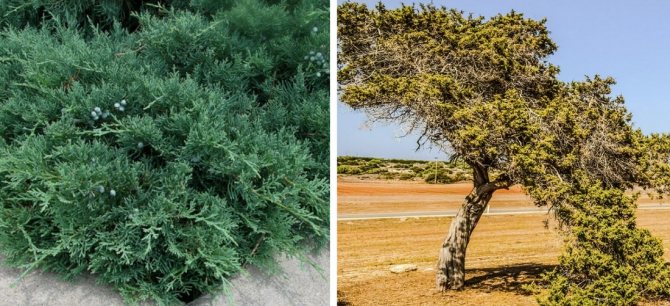

Height
The height of the plant depends on what form it is presented in. In shrubs, it varies within 1-3 m. In trees, this figure is 8-15 m.
What is the trunk of a juniper
The shrubs can grow up to 0.8–2 m in diameter. The trunk of a tree has a thickness of 0.5–1 m. The bark is dark gray or gray-brown, vertically flaky. Reddish on the shoots.
Did you know? Moth never grows in cabinets made of juniper wood.
How the juniper blooms
Flowering and pollination occurs in May, and for specimens growing in northern latitudes, in June. In nature, there are monoecious (form only male or only female flowers) and dioecious (male and female flowers are formed on the same plant) forms. The male flower is a yellow spikelet, the female flower is a green bud. The main difference between a juniper and other conifers is its fruit.


They are not cones, but cones. The diameter reaches 10 mm. Colored in a bright blue color upon reaching full maturity, covered with a waxy coating. Ripen for 3 years. Each fruit contains 2 or 3 triangular ovoid seeds. Coniferous berries have a spicy coniferous aroma. The taste is sweetish, juicy.
Important! Of all the varieties of juniper, only the ordinary one is edible, but it is not eaten raw, but is used in the food industry for the production of seasonings, additives in tea and confectionery. All others are poisonous.
What does juniper smell like?
Like all conifers, heather exudes a pleasant coniferous scent. But it will still be different. The aroma of needles in this species is more subtle, with subtle sweetish-woody notes. In varieties such as Cossack and Smelly, the aroma is more pronounced. It is very harsh, even slightly unpleasant.
How many years does it live
Juniper is a long-lived plant. Its maximum age is 600 years. The first fruiting is observed at 5-10 years. Abundant cone-berry yields appear every 3-5 years. Throughout its life cycle, the plant will bloom and bear fruit.
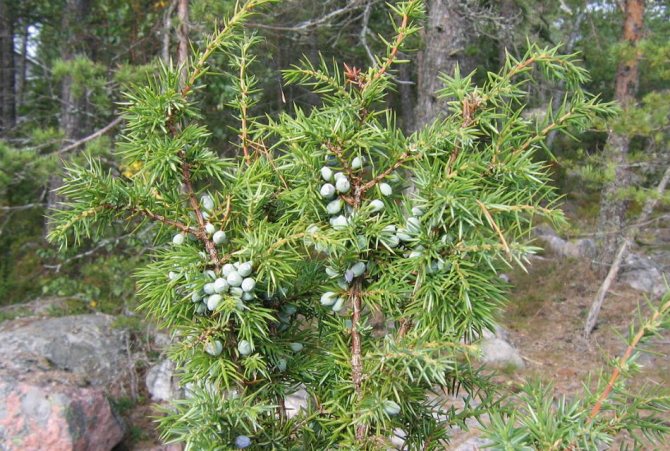

Where hazelnuts grow in the Leningrad region. Garden hazelnut
Dear editors, I have been subscribing to your newspaper for a long time. I am collecting a subscription, since it is impossible to remember all the tips. I re-read it from time to time according to the season. I have a question. Friends donated a handful of nuts from their garden. In appearance they are very similar to nuts, which gives an ordinary hazel in the forest, but they said that this is "garden hazelnuts". How to plant correctly? How to care? I would not like to upset my friends if I fail. They say that it is necessary to plant 2-3 varieties. What varieties to buy?
N.G. Polukhin, Yaroslavl region
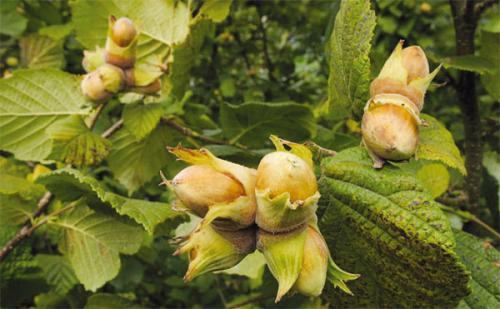

HAZELNUT AND HAZELNUT - WHAT IS THE DIFFERENCE?
There are about 20 species of different hazel in the world (8 of them grow in our country). Common hazel inhabits the entire European part of the country up to the Urals, the northern border of the range runs along the Leningrad region. It is from this hazel that we collect hazelnuts.
Hazelnut is also hazel, but this name is understood as high-yielding selective forms of large hazel (Lombard), its interspecific hybrids with Pontic hazel, and sometimes with other related species.
Hazelnuts are a more thermophilic plant, therefore NOT all hazelnut varieties are suitable for growing in the Middle Lane.
WHY ARE MULTIPLE SHUSTERS?
To obtain a harvest, hazel requires cross-pollination. In the garden, you need to have at least two, and preferably three, four bushes.The plants are large, and not everyone dares to plant so many bushes. As a result, they are left without a crop, or it is very small.
An excellent way out is to negotiate with neighbors and plant four bushes with them. Note: the bushes should be of different varieties, and not propagated from the same plant!
Hazel is an excellent hedge crop. The bushes grow tall and dense, blocking out noise and dust. In addition, a special microclimate is created in the garden, which protects other plants from cold winds.
WHAT VARIETIES TO BUY?
In the middle lane, varieties are grown that are adapted to our climate. Therefore, seedlings need to be bought in local nurseries and not taken from the car along the road or in spontaneous markets, where southern plants are often sold. Perhaps they will not die in winter, but they will rarely yield crops, since flower buds freeze slightly in winter.
Varieties for the Middle Lane: Academician Yablokov, Isaevsky, Moskovsky early, Pervenets, Purple, Kudriif, Tambovsky early, Ivanteevsky red. The best pollinator is Moscow Ruby.
LANDING AND CARE OF THE HAZEL
Naturally, hazel grows in the underbrush and tolerates shading. It also does not require fertile soil. However, to get larger, filled nuts, it is better to plant it in a bright place and apply compost or other organic fertilizers before planting.
But hazel loves watering. In the forest, the soil is always moist due to leaf litter. On sandy, rapidly drying soils, abundant watering and mulching of the root zone is necessary.
Pruning is also required. The bush grows quickly and the shoots shade themselves. An adult shrub should have 15-20 stems. The old and the weak are cut as close to the ground as possible.
Another important technique is protecting the hazel from frost. However, not everyone can do it. Hazel blooms early, even when there is snow. At this time, frost can destroy future crops. At temperatures below -3-4 C, pollen dies.
A technique such as smoking will help preserve the harvest. Bonfires are made next to hazel and fumigated at night and early in the morning. We rarely carry out such actions, so the harvest of nuts is very unstable. Usually from 10 years only 3-4 years are fruitful.
Where it grows
The vegetation under consideration has a fairly extensive range, spreading throughout the world. Its natural habitat is temperate and tropical climatic zones, as well as steppe and forest-steppe.
We advise you to find out when is the best time to replant junipers to a new location.
Places of greatest distribution:
- Europe;
- Asia;
- North America;
- North Africa;
- Russia.
Juniper thickets can be found on any type of soil, but most often they are on dry, depleted ones. Mostly these are sandy loam and podzolic soils. However, the plant can also settle in wetlands.
Classification of trees
Conifers.
1. Conifers (evergreen) - these trees belong to the domain - eukaryotes, the kingdom - plants, department - conifers. They grow in a temperate climatic zone, as they love a moderately warm climate and sufficient moisture. The largest number of species is found in the northern hemisphere. Their sizes can be from a dwarf to a giant.
In the modern world, conifers are woody plants with one trunk and side branches located on it. These are araucaria, pine and cypress trees such as spruce, cypress, juniper, sequoia, yew, cowrie, fir, cedar, pine and larch. If a plant has cones in which seeds develop, and the leaves look like long needles, then it can be safely called coniferous.
Juniper varieties
A fairly large number of juniper varieties have been identified. All of them are distinguished by interesting external characteristics and unpretentious care.
The most popular varieties of common juniper:
- Pyramidal - the cultivated form of the species in question.It is a tree with a narrow crown. The branches begin their growth almost from the ground itself. Pressed against the trunk. The needles are soft, dark green. The culture tolerates light shading well, is frost-resistant, and is completely undemanding to the quality of the soil. Looks good in group plantings. Suitable for area zoning, creation of alpine slides and rockeries. Pine berries are actively used in the alcoholic beverage industry (they make gin, vodka), and in brewing. Also, the fruit extract is used as a spicy additive in sweets, sauces.
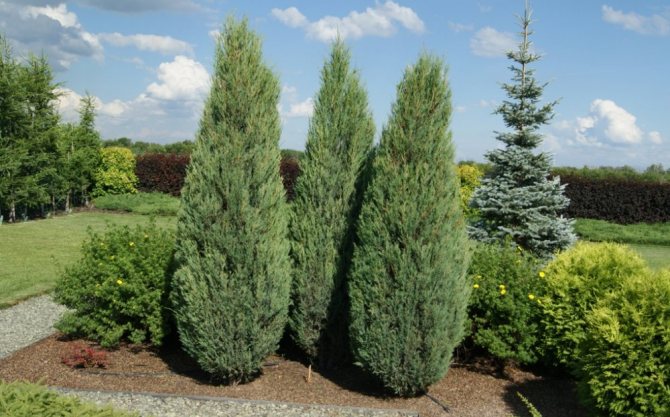

- Cossack - a dioecious bush that grows rapidly in width. Its height does not exceed 1.5 m. The bark is red-brown, rough. The leaf plates are scale-like. When cultivating for the purpose of landscaping areas, it should be borne in mind that the variety is not very resistant to such a disease as rust. The essential oil is used to make topical medicines.
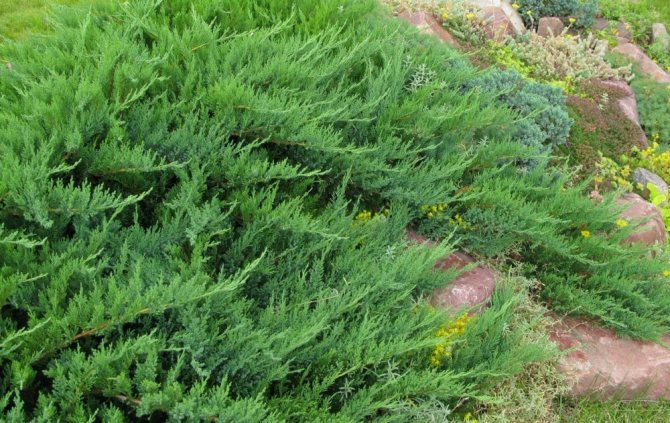

- Horizontal - a dioecious creeping bush no more than 0.3 m high. Its wood is resistant to decay. The plant is cultivated specifically to create unique landscape compositions. It will look very impressive in combination with shrub and woody forms. Thanks to the creeping shoots, it seems that a green carpet is spread on the ground.


- Daursky Is another creeping form. Plant height does not exceed 0.5 m. It grows in breadth due to the formation of roots on shoots, almost lying on the ground. It is used in landscape compositions, as well as for strengthening the soil in mountainous areas. Needles are used in alcoholic beverage production.
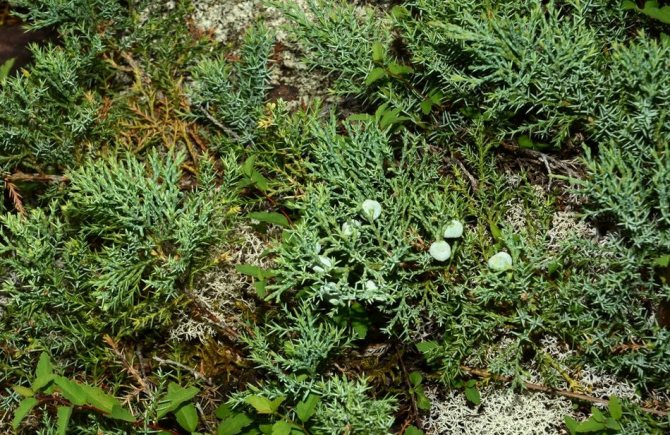

- Coastal - a creeping representative of the considered species. It is planted on depleted or saline soils. Forms a beautiful gray-green carpet.
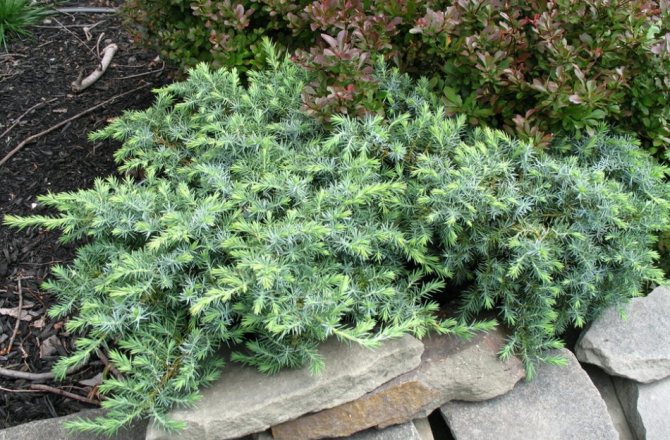

Diseases and pests arising from the care of juniper
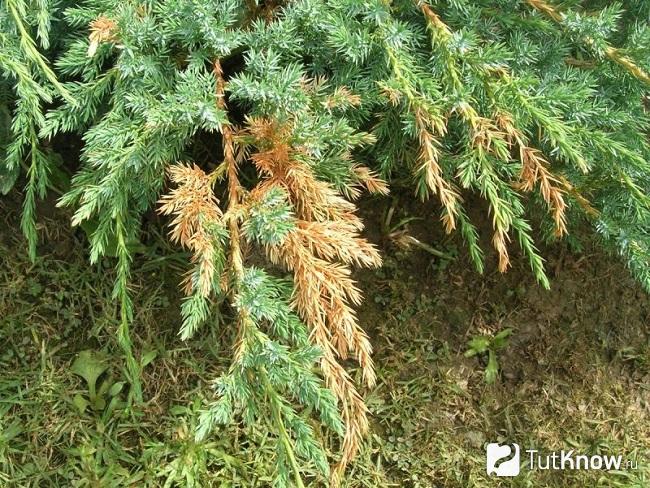

Of the diseases that affect the varieties of heres, there are:
- rust, which arises from the salting of the substrate, the needles acquire a dirty orange color;
- when waterlogged, the needles turn yellow, and then fly around, but drought also leads to the same;
- from rusty growths, use immunostimulants and micronutrients, after the affected parts of the plant are removed;
- the Schütte fungus manifests itself as small black growths on last year's needles, you will need to cut and burn the affected parts, treat with copper and sulfur preparations;
- to prevent various fungal diseases, it is recommended to use copper sulfate.
The plant can be affected by aphids, scale insects and spider mites. For the fight, insecticidal and acaricidal agents are used.
How and where is juniper wood used
The wood of the described plant has found wide application in various spheres of human activity. High-quality pencils are made from it. Dried juniper wood does not crack and has a high density, which allows it to be finely carved.
Find out more about the application of cherry wood.
Also, the material has a beautiful structure: it does not have deep resin passages, therefore it lends itself well to staining. Juniper resin, which is extracted from wood, is no less valuable. It is used in the paint and varnish industry to produce high quality white lacquer coatings.
Video: cutaway juniper
Interesting facts about tall juniper
The tall juniper has been known since antiquity and has been captured in myths and legends:
- With the help of a fragrant tree, which has sleeping pills, Jason and Medea euthanized the snake that guarded the Golden Fleece in Colchis, thereby completing their mission.
- A smell emanates from the needles, which cures many diseases, since this tree purifies the air much better than other conifers. Thanks to the healing aroma, the ancestors fumigated the room where the seriously ill were, and the Ancient Romans got rid of the cholera outbreak.
- Juniper is a leader among conifers in the content of bactericidal essential oils.A hectare of juniper forest is capable of disinfecting the air in a large metropolis.
- Juniper wood is highly rot-resistant. It was used to build basement floors in the famous Genoese fortress in Sudak. Over the 700-year history, the columns of wood did not fail and steadfastly hold 3 floors, while the stone walls of the tower need reconstruction for a long time.
Growing features
The cultivation of the considered group of plants will not cause any trouble. This is ideal for those who are limited in territorial area, but want to grow a coniferous variety. Also, the described plant is suitable for those who have a dacha far away and do not have the opportunity to constantly devote a lot of time to caring. Planting can be carried out anywhere on the site - the main thing is that it is well lit by the sun.
Minimal shading is acceptable. Landing is carried out in April - May, depending on climate conditions. Seedlings are selected at least 3 years old - they take root better. They are sold in containers with a volume of 5 liters. When transplanting into open ground, it is imperative to keep an earthen lump. A distance of 2 m is left between large plants, 50 cm will be enough for small ones.
Important! When planting, make sure that the root collar rises 5–8 cm above the ground level. Otherwise, the seedling may not take root.
Landing is carried out by the transshipment method, having previously dug a hole 2 fingers larger in diameter and height than the container. The planted plant is watered with 5 liters of water, and then mulched with sawdust or peat. The mulch layer should be about 8 cm. Throughout the season, plants should only be watered in extreme heat. For one instance, you will need from 10 to 20 liters of water.
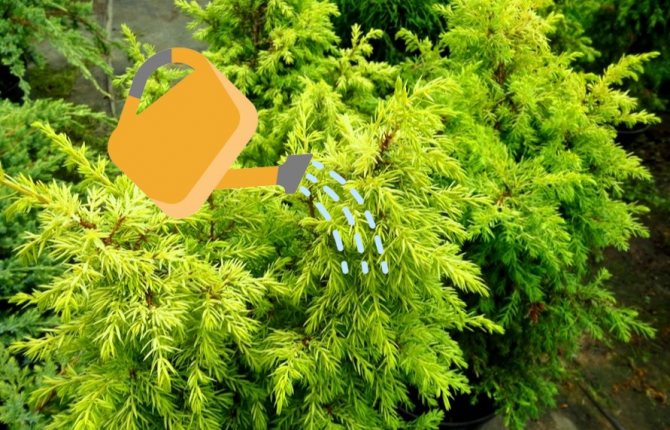

The trunk circle is loosened once a month. Weeds are removed regularly. Fertilized once a year, in the spring: 30 g of nitroammophoska are embedded in the trunk circle. Plants do not need pruning. Such manipulation is carried out only when it is necessary to form a hedge. Sanitary pruning is done as needed. At the same time, branches are removed that thicken the crown and grow inward.
Video: common juniper
Forest trees of central Russia with photos and names: oak, birch and linden
Of course, everyone knows such names of trees in central Russia as oak, birch and linden.
English oak (Quercus robur) reaches a height of 20-40 m. It can live up to 2000 years, but usually lives for 300-400 years.
The name of such a Russian tree as common birch (Betula pubescens), is strongly associated with our country. Birch grows throughout the European part of Russia, in Western and Eastern Siberia, in the Caucasus mountains, and is one of the symbols of the state.
Reaches 25-30 m in height and up to 80 cm in diameter. The bark of young trees is brownish-brown, and from 8-10 years old it turns white. Lives up to 120 years.
The birch root system is highly developed, but it does not penetrate deeply into the soil.
Leaves are ovate or rhombic-ovate, 3.5-7 cm long, 2.5-5 cm wide.
The tree is monoecious, but the catkins are dioecious. Fertile catkins 2.5-3 cm long, with pubescent legs, seed scales 3-5 mm wide, ciliate along the edge.
Leaves and buds are used in traditional medicine.
Heart-shaped linden, or small-leaved linden (Tilia cordata) is common in the European part of Russia, especially in the Urals.
Deciduous tree 20-38 m tall with a tent-shaped crown.
The bark is dark, furrowed on old trees.
Leaves are alternate, cordate, long-petiolate, dentate, green above, glaucous below.
The flowers are regular, bisexual, with a double five-part perianth, up to 1-1.5 cm in diameter, yellowish-white, odorous, collected in drooping corymbose inflorescences of 3-11 pieces. Blooms from early July 10-15 days.
The fruits of this tree of the forests of Russia are spherical, pubescent, thin-walled, one- or two-seeded nuts. The fruits ripen in August - September.
Linden blossom is used as a flavoring agent in perfumery, in the production of cognacs and liqueurs, and also as a substitute for tea.
Honey plant. In terms of taste and healing qualities, linden honey has long been considered the best.
The largest juniper in the world
The largest and oldest veres grows in the Crimea at Cape Sarych. It reaches a height of 12 m. The diameter of its trunk is 4.9 m. According to rough estimates, the age of the tree is 2000 years.
Learn how to tell the difference between a thuja and a juniper.
Juniper is a coniferous plant that is widespread throughout the world. They are easy to grow with little effort. Due to its high decorativeness, a garden with such vegetation will always look elegant.
Common ash (Fraxinus excelsior)
Distributed in the European part of Russia.
The tree is 20-30 m high and with a trunk diameter of up to 1 m. The crown is highly raised, openwork.
The bark is gray. Leaves are pinnate, consist of 7-15 leaflets. The leaves are lanceolate, bright green above and light green below. The flowers are small, bisexual.
Honey plant.
Types of forest trees willow and alder
Speaking about which trees are found in the forest, of course, it is worth mentioning willow and alder.
Willow (Salix) is a tree up to 15 m or less tall shrub. There are about 170 species of willows.
Due to the ability to give adventitious roots, willows are easily propagated by cuttings.
Leaves are alternate, petiolate.
The stem is branched, the branches are thin, rod-shaped, flexible, brittle, with a matte or shiny bark.
Juniper benefits. Juniper: medicinal properties and contraindications, benefits and harms
Spectacular evergreen, aromatic trees and shrubs are increasingly decorating winter gardens and summer cottages. Juniper is one such plant. Frost-resistant, shade-tolerant and unpretentious to soil conditions, it not only diversifies the landscape, but also releases many phytoncides into the atmosphere.
Structure
Juniper is a genus of evergreen shrubs and multi-stemmed trees of the Cypress family. Grows wild in Europe, North America, North Asia. It is cultivated as a medicinal plant in Hungary and Italy. In nature, it occurs in the mountains, in the forest-steppe and steppe zones, sometimes it forms whole thickets.
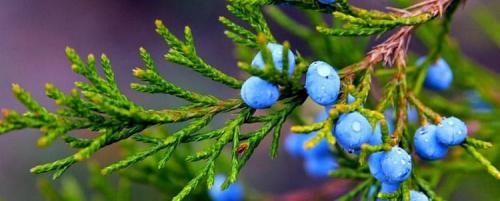

The branches and trunk are covered with dark gray or grayish brown smooth bark. Leaves (needles) - thorny, thorny. Nondescript flowers (cones) are absolutely invisible during flowering, but after pollination they are reborn into shiny cones with a gray waxy bloom. Other names: heather, heather tree, yadlovets, grouse bush.
The most valuable medicinal raw materials are juniper berries, which contain:
- essential oil with a high content of terpenoids (cadinene, dipentene, sabinene, juniper camphor, zedrol) and esters rich in valeric acid;
- a specific bitter substance containing the pigment uniperin;
- sugar (up to 40%);
- resinous substances;
- fixed oils;
- waxes;
- organic acids;
- trace elements: manganese, iron, copper, aluminum;
- flavonoids;
- pectins.
The bark contains up to 1% of essential oils, tannins, needles - a large amount of vitamin C.


The calorie content of the fruit is 116-118 kcal per 100 g.
Beneficial features
Juniper belongs to relict plants, the age of some reaches 600 years. Even in Ancient Greece, it was actively used as a healing potion. What are the health benefits of juniper?
- The main component of the fruit is terpenoid compounds. This most studied group of organic anti-inflammatory compounds is widely used in the preparation of medicines (the most famous is camphor). It has been scientifically proven that coniferous terpenoids help the body fight viruses, fungal infections at the cellular level, and reduce the manifestation of allergic reactions.The aroma has a relaxing effect, and when applied externally, it relieves muscle pain, arthritis, burns and trophic ulcers.
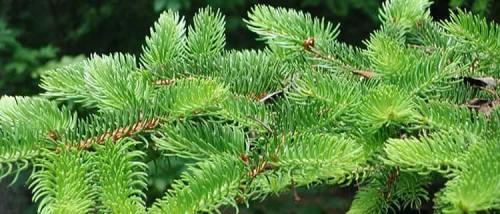

- Bitter substances gently irritate the intestinal mucosa and walls, which contributes to their intense contraction. As a result, digestion and intestinal motility are improved, and the fermentation process is reduced. In addition, bitterness stimulates the production of pancreatic secretions, activates the liver detoxification process, and contributes to a feeling of quick satiety.
- Acetic acid has a powerful effect on pathogenic and pathogenic microorganisms, formic acid - successfully fights inflammation of the joints, apple - stimulates metabolism and has a positive effect on the work of the heart ..
Appearance, methods of reproduction, soil requirements
Amaranth - what kind of plant, where it grows, what it looks like
It is impossible to say unequivocally what a juniper looks like. Shrub forms can grow up to 3 m, and those growing in the form of a tree have a height of 10-12 m and more. Male specimens of the plant are characterized by a columnar dense crown. For women, it is spreading, oval in shape.
Juniper needles on young bushes are always green, sharp, needle-like. In adult specimens, it can be either needle-like or scaly.


Flowering juniper
The flowering culture begins in May. Male flowers have an elongated or spherical cone shape and a yellow color. Female flowers are greenish, gathered in groups, after fertilization they become like brown dense balls. In the next season, the fertilized cones are filled with juice and take on the appearance of a berry. By autumn, their color becomes red-brown or deep blue.
You can see what roots the juniper has when buying and transplanting it. The root system of most shrub species is fibrous, superficial. It is located in the top layer of the soil, so the culture grows even on poor rocky soil.
Note! A tree-like juniper has a powerful taproot that goes deep, so such junipers do not tolerate transplanting and may die, because during the procedure, damage to the root system is inevitable.
Plants propagate by cuttings, layering and seeds:
- Reproduction of juniper using seeds is the easiest, but longest way. Seed material of some varieties can be in the ground without germinating for up to 4 years, and fruiting will be delayed until 10 years of age.
- Cuttings are best done in spring. For this, the shoots are cut at the beginning of February. The appearance of the roots will have to wait a month or longer. The tops of shoots 25 cm long, cut with a sharp knife, are used as material. Juniper is rooted in a mixture of humus and peat.
- It is permissible to propagate only creeping species by layering. The method can be used during the entire growing season. Several horizontal branches are pinned to the ground and lightly sprinkled with peat. The formation of the root system of juniper on the layers occurs within 6-12 months. It is possible to separate a young bush from the mother plant only when it is sufficiently developed and has vertical shoots.
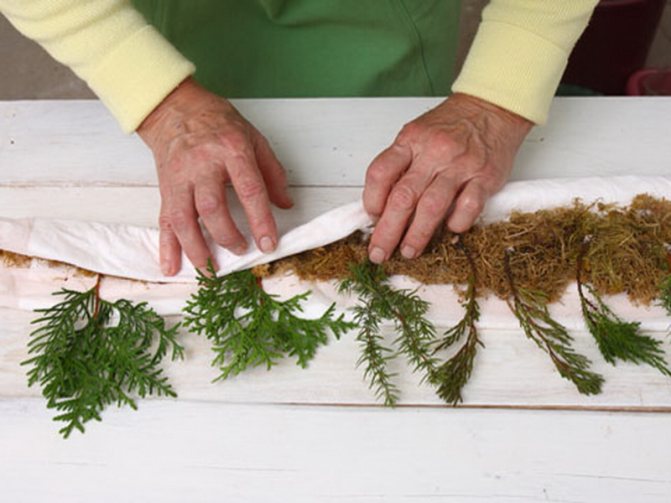

Propagation by cuttings
In nature, juniper is able to grow even on poor soils, but for good crop growth, it is better to additionally fertilize the soil. It is necessary to take into account the species preferences of the ephedra. For example, Virginia juniper grows better on loam, and Cossack juniper needs lime soil.
Heather symbol. The magic of plants. Heather. Heather: signs and superstitions
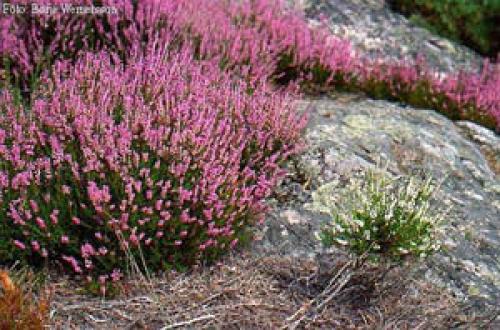

Heather. Magical use
Aura: Cold Planet: Venus Element: Water Deities: Isis
Basic properties: protection from evil forces, rain call. Heather is used in magical rituals to cleanse the dwelling and courtyard from evil spirits and evil spirits. Heather served for ritual decoration of magic circles, altars and houses during the pagan holidays of Imbolg (Brigitte's Day, Oymelk) - February 2, Samhein (Halloween, Spirits day, Hellomus,November Christmastide) - October 31, Lagnasad (Lammas) - August 1.
White heather is used to make talismans and amulets, as it is believed to bring good luck and protect women from violence. Heather is called "rejuvenating herb" and "the herb of immortality", it is believed that with constant wearing it prolongs life. Helps in working with the inner self.
In magical practices, it is used to make it rain (in the open air it is burned with a fern) and in spiritual contacts.
Carry it in your wallet and it will help you “grow” your money.
Specific Use: Carried with you to protect against rape. Burned together with the fern to make it rain. Heather dispels any witchcraft. It is good to plant heather in the garden, best of all from the east and north sides. It will bring protection to your home, good luck and financial well-being for you. To get rid of the witchcraft sent to the house (when everything in the house breaks down, in the room, despite regular ventilation, there is musty air, the appearance of many insects is observed), it is necessary to fumigate the room with heather. This should be done several times, the first time - on the first evening of the full moon, and then 4 more times, two evenings later on the third. As soon as the moon appears in the sky, you need to take as many white saucers as there are rooms in the house (including a pantry and a toilet). Place dried heather in a slide on each saucer. Starting from the front doors, go counterclockwise, bring one saucer of heather to each room. In the room, burn the heather and, holding the saucer in front of you, go around the room counterclockwise 3 times. Then place the saucer of incense heather on the far right of the door. After that, go to the next room and do the same. In the early morning, collect all the heather ash saucers, take out the ashes and spread them in the field near the house. On the third evening and 3 more times, repeat the same.
All about herbs and more
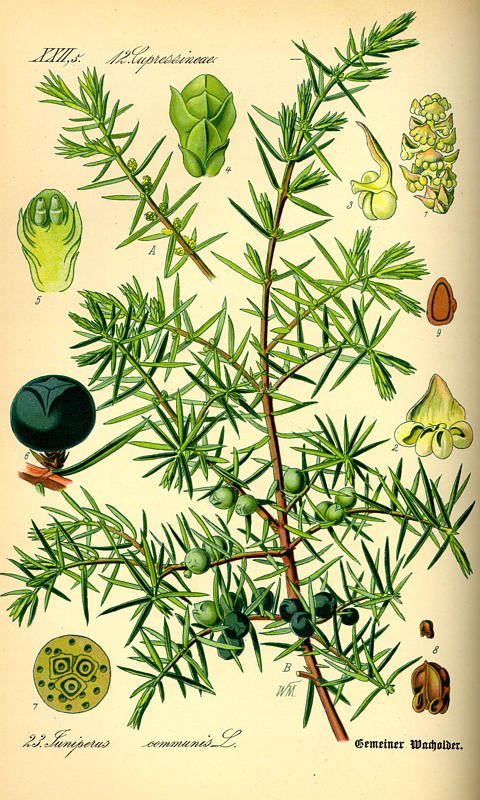

General information
Family: Cypress (Cupressaceae). Botanical name - Juniperus communis L. (Juniperus - prickly, Juno plant) Pharmacy: Juniper fruits - Juniperi fructus (formerly: Fractus Juniperi), juniper essential oil - Juniperi aetheroleum (formerly: Oleum Juniperi). Generic name: genus of evergreens Asteraceae Popular names: Sabina-herba - Sabine potion. Cedres miera - small cedar (ancient Greeks) In Russia, the juniper was called "mozzhukha", or "veres". There is no consensus among researchers about the origin of the Russian plant name. Most often it is associated with the words "mezh spruce", "brain" - because of strong vigorous wood, and the old Russian word "mozhzha" - knot.
Dahl wrote in his dictionary: The people, in different places, confuse the names of plants, and our scientists, no less than that, write without hearing: heather, heather, instead of heather; ars, vm. ars; ardish, vm. artysh, etc. Juniperus communis, juniper, juniper, bryophyte (mesenteric), cereal, cerebral, elelenets, yalovets; in places, mistakenly heather (Calluna, Erica); Juniperus daurica, sib. juniper, juniper, steppe heather; Juniperus Marschalliana, ardysh, artysh, red cedar, cedar heather, Spanish juniper; Juniperus Sabina, Cossack or Don juniper, Cossack cereal; archa, arshan, arsa, artsa, akhra, artysh; Juniperus pseudosabina, arsa, arts.
Planet: - Sun, Saturn, Mercury Zodiac sign: - Leo Element - fire Language of flowers: - promise of eternal life, hospitality Main properties: - protection, love, prevention of theft, scaring away snakes
Description: Common juniper is an evergreen coniferous shrub, the fruits of which are used as a spice. Shrub or small tree up to 5-6 m tall with gray-brown longitudinally flaky bark. It grows slowly, especially in thickness, sometimes in centennial specimens the diameter barely reaches 10-15 cm. Young shoots are reddish-brown, triangular. The buds are small, without scales and covered with scaly needles, smaller than the rest of the needles. Needles (needles) 1-2 cm long, arranged in whorls (3 each), rigid, prickly. Cones are spherical, almost sessile, up to 7-9 mm in diameter, initially green, bluish-black when ripe, with or without a bluish bloom. The wood is quite soft, well cut, with a grayish or reddish-brown core and a narrow light yellow sapwood. The plant is dioecious.This is one of our long-livers: its lifespan is from 600 to 3000 years. It is undemanding to soils, but picky about lighting conditions. It grows mainly in dry spruce and pine forests in the form of undergrowth, distributed almost throughout the forest area. In autumn, female bushes (juniper dioecious plant) are covered with a mass of black, with a bluish bloom, cones (cones) with fleshy, accrete scales. The smell of juniper fruit is spicy and light, reminiscent of the smell of meadows and forests. The taste is bitter and spicy, resinous and sweetish. Ripe juniper fruits contain up to 42 percent sugar, that is, the same as in grapes. Small trees are large. up to 10-12 m, less often up to 20-30 m, or shrubs, sometimes creeping. Leaves are opposite in pairs, or less often in whorls, 3 each, acicular in young and scaly or acicular in adults. Microstrobili are small, oval, in the axils of leaves or at the ends of lateral shoots, ripen and grow dusty in the spring, in the 2nd year. After fertilization, megastrobils grow rapidly, grow together, turning into juicy cones (gl. Distinguish, a sign of M.), blue-black or maroon, ripening in the 2-3rd year (sometimes they are called cones or juniper berries) ... Depending on the species, the bud contains from 1 to 12 seeds. Juniper propagates by seeds and rooting of branches (elfin forms in the mountains). The root system is powerful and deep. In total, there are about 60 species, in the North. hemispheres (in East Africa enter the southern hemisphere), in the undergrowth of light forests or thickets on the plains and especially in the mountains. In Russia - approx. 30 species (in Central Asia, they are called archa). The most famous are the Eurasian Common Juniper (J. communis) and the Cossack Juniper (M. sabina) - a creeping shrub up to 1.5 m high, with scaly leaves, growing on the mountain slopes from South. Europe to the Center. Asia. Ornamental species: High juniper (J. excelsa), Smelly juniper (J-foetidissi-pga), Hard juniper (J. rigida), Sargent juniper (J. sargentii) - listed in the Red Book of the USSR (Russia) and need protection.
Growing places: In thinned pine forests, on the edges, in old clearings, along sandy hills, it is easy to find a branched coniferous shrub 1.5–2 meters high.
Parts used: For medicinal purposes, juniper berries are used, which are harvested after they ripen, in the fall. Leaves, branches and bushes themselves as ozonators of parks and forest plantations (sanatoriums, boarding houses, etc.).
Collection and procurement
The so-called "berry duty", which existed in the 17th century, speaks of the widespread use of juniper in Russia. The collected berries in large quantities were taken to Moscow to the Aptekarsky Prikaz, where they extracted juniper oil and drove juniper alcohol. In juniper oil, healers kept threads for suturing wounds, and treated fresh cuts and decaying wounds with it. Collecting pine berries is a rather laborious task due to the sharp needles. To facilitate it, a cloth is spread on the soil and ripe cones are shaken off on it; however, then it is necessary to thoroughly clean them of dry needles and twigs that have fallen along with them. "Berries" are dried in a ventilated place. Harvest time is October. Active ingredient: essential oil. Juniper cones are harvested in October by carefully collecting ripe fruits in a canvas bag. Special devices for collection are not required, since nothing will help to hide from the needles, but thread gloves will come in handy, as they will save from the resin. Ideally, the buds should fall off on their own by shaking the bush lightly. It should be harvested immediately, as many birds love these fruits, the cones should be dried in the shade, and it is better to use them immediately to prepare the syrup. Juniper branches and needles are harvested in autumn or spring, after the end of the active growing season. Juniper oil should be prepared immediately from fresh needles and wood, as well as berries.
Medicine:
Scientific studies have shown that the bactericidal properties of juniper essential oil are unmatched, and that no tree releases as many phytoncides as juniper. It was even calculated that one hectare of juniper forest per day can improve the air of a big city, so they willingly began to plant it in cities, but, unfortunately, the conditions of the city destroy this useful plant. Modern medicine recommends taking juniper cones as a diuretic, disinfectant, expectorant. It is also indicated for the tonic, anti-inflammatory, antipyretic, analgesic, tonic, stimulating digestion, choleretic properties of this plant. It is also known the disinfecting and anti-inflammatory effect of juniper oil on the urinary tract, as well as detoxification properties that are used in cleaning procedures. Noteworthy is the beneficial effect of this oil on the digestion process. This can be confirmed by patients who have successfully taken juniper oil for bloating and heartburn. From juniper, as well as from grapes, they get wine, shingles, vodka, cognac, beer and the famous English gin. The khaki and greenish-yellow paint is given by the berries and bark of the juniper. The fact that the household did not do without juniper, we read in the surviving manuscripts of the ancient Egyptians, Greeks and Romans. Very beautiful, unusually strong wood with an exquisite aroma was used for the manufacture of furniture, kitchen utensils, toys, amulets, icons. With a juniper broom they liked to steam in a Russian bathhouse. They fumigated huts with Veres to clear the air and get rid of annoying insects. Heather threads were especially strong, they were used to sew boards for boats and schooners together. Juniper oil was one of the main components of the varnish used by the old masters of musical instruments. Active substances: The main active ingredients are monoterpenes: pinene, mikrin, sabinene, limonene, terpinene, camphene. Essential oil of juniper fruit (mainly terpineol) enhances filtration in the renal glomeruli and inhibits the reverse resorption of sodium and chlorine ions in the convoluted tubules of the kidneys. Galenic preparations of juniper fruits increase the secretion of bronchial glands, increase bile formation and bile secretion, increase the secretion of gastric juice. Infusion of juniper berries contains vitamins, trace elements, substances with antiseptic action, as well as compounds with anti-inflammatory, expectorant, laxative and diuretic effect. Infusion of juniper berries disinfects the urinary tract, so they can replace extracts of berries and leaves of lingonberry in the treatment of pyelonephritis and cystitis.
Ethnoscience:
Juniper is a well-known medicinal plant, its fruits are popular in the treatment of diseases of the urinary tract and stomach, they have a diuretic and diaphoretic effect, stimulate the formation of gastric juice, they are also used to treat rheumatism and cough, flatulence and diarrhea. Milk in a jar made of this tree does not turn sour even on a hot day, and vegetables salted for the winter do not spoil for a long time in barrels steamed with juniper. Juniper wood does not rot and even gains special strength over time, so noble people were buried in expensive juniper sarcophagi. In the poem ‘On the Properties of Herbs’ special attention is paid to juniper: As a medicinal plant, juniper was first used in Ancient Egypt, then in Ancient Greece and Rome. One of Mena in the poem "On the Properties of Herbs" writes: He is good for the stomach. So, healing the chest area, He soothes an excessive, even embedded, cough. He is able to help against various poisons, he will help from convulsions, he will also help from breaks.Uterus defect and disease that infertility gives, it takes away; Its juice heals those who are bitten by the viper. So, if he is burnt and mixed with pure water, Then he will expel leprosy from the shameful body with anointing. " The sap of wood destroys its intoxication ... The head will be smeared with ointment and this will help her; Hair, the expert assures, - the beauty of the head, preserves; If it falls out, it will become as before, it will hold the fallout itself. Likewise, but with less guarantee, baldness will cure the agony, Growing hair nimbly on the previous head of the ridiculous. North American Indians, taking into account the disinfecting properties of juniper, used an original method of curing tuberculosis patients. These patients were placed in juniper thickets for a long time and were not allowed to leave until they were completely cured. Juniper has long been used in Russian folk medicine. Its cones and seeds in fresh form, in the form of powders, infusions were used for dropsy, cough, asthma, gout, diseases of the stomach and intestines. The belief in its antibacterial properties led to its widespread use in household sanitation: juniper branches were fumigated at home, barns for any infection. “Medicine recognizes the possibility of transmission of so-called contagious diseases through breathing ... The enemy can be defeated only by knowing its strength. Breathing in an infected room is not helpful. Or open air, or thorough ventilation of the room. The air of hospitals, where there was a lot of suffering, is murderous: ozonizers and sun rays are needed. Natural ozonizers - conifers - are the best. < …> Mint and eucalyptus are powerful cleaners, as well as the resin of coniferous trees and coniferous roots ... ”. (Gr A.Y., 5.07.60) Physicians in juniper oil kept threads for suturing wounds, treated fresh cuts and festering wounds with them. The experience of treating nervous diseases with the help of juniper is known. No tree emits as many phytocides as juniper, so it was eagerly planted in cities, but the heavily gassed air destroyed these plants, whose life expectancy in natural conditions reaches 3000 years.
The healing properties of juniper essential oil:
- Recommended for gastrointestinal stone disease, hepatopathies associated with bile congestion, increases bile formation and bile secretion. It is used as a disinfectant for inflammation of the genitourinary system. Effectively for bladder papillomatosis, urinary retention and urolithiasis.
- It is used for the treatment of gastric ulcer, improves digestion and intestinal motility, with gastroenteritis, intestinal distention, heartburn.
- Pain reliever for colic caused by indigestion and bloating.
- A potent remedy for violation of the exchange of fluids in the body. Provides a diuretic for edema associated with renal failure, impaired blood circulation, heart, liver.
- It dilutes phlegm well, eliminates inflammation in the lungs and bronchi.
- It is used for tuberculosis, chronic respiratory diseases.
- Effective for diseases associated with metabolic disorders.
- Promotes the excretion of uric acid from the body (which is important in the treatment of rheumatism, gout, arthritis), cholestrol (which is necessary in the treatment of atherosclerosis, diabetes mellitus).
- Increases the elasticity of blood vessels, cleanses the blood.
- Lowers blood pressure.
- Is taken with leucorrhoea, delayed menstruation and pain associated with them.
- Recommended for obesity and weakening of the subcutaneous connective tissue (cellulite).
- Prescribed for inflammation of the skin, acne, seborrhea, wet lichen, scabies, eczema, dermatitis, fungal diseases.
- It causes intensive regeneration of the skin, accelerates the healing of thermal burns.
- Strengthens the immune system.
- In folk medicine, it is used to treat hemorrhoids, purulent wounds, as well as for varicose veins, cracks in the skin, ear pains, gum inflammation, gout, malaria, and lack of appetite. They are used as a means of promoting the rapid recovery of the patient, for obstetrics, cleansing the body of toxins and restoring sexual function.
- Calms the nervous system during stressful conditions, obsessive fears. Tones up, relieves mental fatigue, can be used as a sleeping pill.
- Suitable for normal to oily skin care, as it cleans pores well and has drying properties. Stimulates the renewal of skin cells. Eliminates dandruff.
- Scares off ticks and fleas.
The therapeutic effect in diseases of the kidneys and liver is observed even when chewing juniper cones. The first day - 4 berries throughout the day thoroughly chew and swallow, spit out the seeds. On the following days, add one berry daily, and from day 15 - reduce one berry daily to 4 berries a day. Such a reception of pine berries improves appetite, reduces flatulence, has a choleretic, diuretic, disinfectant effect. For cancer ulcers, powders of juniper berry powder help well, and for gout, rheumatism, osteochondrosis - baths with a decoction of berries and needles. Essential oil of juniper is also used for inhalation, as a means of contributing to the rapid recovery of the patient, as well as in tuberculosis, acute and chronic diseases of the respiratory tract. Essential oil inhalation can be hot or cold. With hot inhalation, boiling water is poured into a bowl with a wide neck, a few drops of essential oil are added. Inhalation lasts 3-10 minutes. In the case of cold inhalation, inhalation is carried out directly from the bottle or after application to the aroma medallion (from fine porous clay). Breathing is even and deep, lasting 3-10 minutes. In case of a violation of fluid exchange in the body, leading to the occurrence of edema, experienced aromatherapy specialists recommend taking juniper essential oil internally. In addition to providing a decongestant effect, it is also effective for problems associated with metabolic disorders, with frequent headaches, lethargy, nervous stress, mental fatigue, joint pain caused by gout or rheumatic processes, with high blood pressure.
Magic:
Juniper belongs to the relict medicinal plants, known since biblical times, when it was used to drive out evil spirits. The Indians of North America used the juniper to heal wounds and diseases of the skin, bones and joints, placing the sick in the juniper thickets, where the air was saturated with healing volatile substances. Junipers were burned in French hospitals during the smallpox epidemic. It was also widely used to combat plague and other infectious diseases. In the Middle Ages, the healing properties of juniper were discovered, which are successfully used to this day. It was noticed that the juniper guardian protects against many infectious diseases. For many peoples, the juniper is a symbol of overcoming death and a symbol of eternal life. Associated with this is the rite of covering the last path of the deceased with juniper branches and burning them at the funeral. Since juniper wood does not rot and even gains special strength over time, noble persons were buried in expensive juniper sarcophagi. In ancient Greece and Rome, juniper was considered a sure-fire remedy for snakes. The famous myth of the Argonauts tells how Medea and Jason, with the help of a juniper, euthanized a monstrous serpent guarding the golden fleece. In Russia, it was also believed that juniper seeds, worn on the body, are able to protect against snake bites.It was also noticed that milk in a juniper jar does not sour even on a hot summer day, and vegetables salted for the winter do not spoil for a long time in barrels steamed with juniper. The unfading green of the juniper also seemed amazing, and its special balsamic smell and the number three, which correspond to many parts of the plant (needles are collected in three, three scales in female spikelets, three seeds in cones). All this gave rise to faith in the all-preserving power of this plant and a large number of superstitions and customs associated with it. To this day, there is a custom: the branches of the juniper, consecrated in the church, are kept behind icons, fixed under the ceiling, in barns, considering this as protection from illness and other misfortunes. The plant of protective magic can be used to surround the house with a juniper "fence", as well as grow in a tub in the house, protecting it from enemies and pleasing the eye and stomach with delicious berries. Even the presence of juniper gives a healing effect, not to mention amulets made of this material. By the way, it is believed that a magic wand made of juniper chooses an initiative person as its owner; as well as the one who loves that the last word in the dispute always remains with him. Juniper magic wands are preferred by responsible, courageous and determined wizards.
Myths and legends:
To put the dragon guarding the Golden Fleece to sleep, Medea of Colchis prepared sleepy drops from freshly cut juniper branches. And the fleece went to Jason, Medea's beloved. Potion of the Sabine Women - the name is associated with the Sabine women, the very ones who were kidnapped by the Latins at the festival of Konos, the god of consent. The Sabine women actively used the juniper to create their own, possibly love, potions. Juniper is attributed to the goddess Juno, the goddess of preservation of the marriage bond, fertile and thermophilic. It was under a juniper bush that the prophet Elijah rested on the way to Horeb. And in the book of Job, the juniper berry is food for the poor: "... they nibble the greens near the bushes and the juniper berries, their bread." Mythopoetic ideas about Juniper, cedar, cypress and other similar plants, reflected in ritual practice, are most often guided by their properties such as evergreen, coniferous, characteristic "balsamic" smell (especially when burned). Juniper (as well as cedar and cypress) is associated with the symbolism of death and its overcoming as the beginning of eternal life. Since ancient times, the common custom of burning Juniper branches at funerals and covering the last path of the deceased with them has originated. A special place is occupied by the burning of Juniper, cedar or other close plants for the purpose of ritual fumigation, fragrant incense (from "incense", "smoke", etc.). Such a fragrant fumigation is described by Herodotus and Roman authors (Pliny the Elder, Vergilius, Varro, etc.). In different traditions of the Old and New Worlds, Juniper is used to fumigate houses, stables, and other utility rooms in order to prevent a lightning strike or drive out unclean spirits. According to the Avesta, the followers of Zarathustra were forbidden to use the plant hapbrusl, usually identified with the Juniper, as a common fuel; according to another report of the Avesta, “people who worship devas” brought this plant to the sacred fire. In a number of cases, the names of the Juniper reveal a connection with the theriomorphic code (compare, on the one hand, the Russian dialectal name of the Juniper - "elelenets", that is, "deer", and on the other - the name of one of the species of thrush - "juniper") ... Legends are known according to which an evil spirit or devil lives in the Juniper (compare the Kashubian name for the devil kaduk and the Belarusian dialect name for the devil, the evil spirit - "kaduk"). At the same time, there were beliefs (in Samogitia) about the sacred forest in which the Juniper grows, which is not subject to felling due to the fact that the gods live in it.Sometimes juniper or cedar names were used in theophoric names: according to Pausanias, Artemis in Orchomenos had the epithet “cedar”. Few people in ancient times distinguished numerous types of junipers, calling them in one word - cypress. Cypress in southern Europe and southwestern Asia is a symbol of death, despair, eternal grief, sorrow, but also rebirth, immortality of the soul, joy, mercy. In Greece, in the annual rituals of Aphrodite's mourning for the deceased Adonis, the procession participants carried a cypress. One of the names of Aphrodite (Cypriot) is also associated with cypress, since the name of the island of Cyprus is given by the "cypress" attribute. According to the testimony of Greek and Roman authors, the cypress was dedicated to Apollo, Venus, Pluto, Sylvanas, and others. The club of Hercules, the scepter of Jupiter, and the arrows of Cupid were made from the cypress tree. In the ancient tradition, cypress was considered as a tree of mourning, dedicated to the god of the underworld and the Erinians (furies). Once he was a young man who, having accidentally killed his beloved deer, turned into a tree from grief (Ovid. Met. X, 120 next). In ancient Iran, the cypress was revered as a sacred tree due to the fact that the word of Ahuramazda was carved on it. The Phoenicians sometimes replaced the conical stone dedicated to Astarte with cypress. The ancient Jews on the Feast of Tabernacles used cypress and myrtle to build tents. The Zion cypress was considered an attribute of the Virgin Mary. The etiological motives associated with this tree are also quite common (the Iranian version of the cypress shoot brought by Zarathushtra from heaven; myths about the cypress as a converted mythological character). It is believed that the juniper dreams of happy changes in life; a dream in which a juniper was present promises wealth and good luck in all matters. Juniper girls dream of love or good changes in love relationships. If a sick person dreams of a juniper bush, this dream portends a speedy recovery.
Recipes, infusions, decoctions:
Magic recipes An infusion of berries is used as a medicine. It is prepared using conventional technology in a ratio of 1:20. 5 g of crushed juniper berries are poured into 250 ml of boiled water at room temperature and infused for 10-12 hours or cooked in a water bath for 15 minutes in a tightly sealed container. Then the infusion is filtered into a thermos and drunk 1/3 cup 3 times a day 15 - 30 minutes before meals. Also, finely chopped needles or juniper wood are used to sanitize the air in the room: 10-20 g are poured with 150-200 ml of water and boiled for 10-15 minutes. At the same time, the essential oil evaporates with water and, in the form of steam, aromatizes the air in the room, at the same time disinfecting it. Inhalation can be carried out in the same way. Essential juniper oil can also be used to prepare an ointment for scabies: 50-60 drops per 30 g of base (petroleum jelly, vegetable oil). Juniper Oil Dosage:
- For massage: 4 - 5 drops per 10 ml of vegetable oil.
- For internal use: 1 - 2 drops per 1 teaspoon of oil 2 - 3 times a day for a month.
- For baths: 5 - 6 drops.
- For applications: 6 - 6 drops.
- For compresses: 6 - 7 drops.
- For the enrichment of cosmetics: 2 - 3 drops per 5 g of base.
To obtain syrup, juniper cones are kneaded without crushing the seeds, since they contain bitterness. A kilogram of crushed berries is placed in a saucepan with 3 liters of water heated to 40 ° C, stirred for a quarter of an hour, then the berries are removed and squeezed out. Putting the second and third portions of fresh berries in it, you get a juice containing up to 20% sugar. By evaporation in a water bath, a juice containing up to 60% sugar is obtained. Juniper sugar is one and a half times sweeter than beet sugar.
Cooking Applications:
Juniper fruits are used for the production of the famous juniper vodka and gin, they are part of many spice mixtures.First of all, juniper is used in all methods of cooking game, dark sauces, meat products, mainly fatty pork and lamb (several berries). Food lovers appreciate the excellent flavor of sauerkraut after the addition of the juniper fruit. It was thanks to him that the cabbage, fermented in barrels, became famous all over the world. It also improves the aroma of Savoy, red cabbage and beets. Veres sprigs were used as a spice for all kinds of pickles, powdered berries were added to gingerbread dough, and strong drinks were prepared from them. You can get syrup from juniper, from which you can get sugar, jelly, jelly, gingerbread, gingerbread, sweeten tea and coffee.
Juniper tea. Take 2 tbsp. tablespoons of juniper fruits, put in a porcelain teapot, pour 4 cups of boiling water. Drink like tea. An excellent remedy for liver inflammation.
Juniper fruit powder. Grind dried fruits in a coffee grinder or grind into powder. Take 1/4 teaspoon on the tongue 3 times a day without drinking anything. The tool helps to stop pain in inflammation of the biliary tract.
Juniper syrup. 2 teaspoons of chopped juniper fruits pour 2 cups of boiling water. Let cool and strain. Then it will boil the infusion with sugar in a water bath to the consistency of a syrup. Take 1 teaspoon 3 times a day. This remedy treats chronic skin diseases - eczema, psoriasis, neurodermatitis.
Juniper fruit tincture. Prepare a tincture of 15 grams of fruit and 100 ml of alcohol. It should be used for rheumatism as a pain reliever.
Baths with a decoction of juniper fruits. Boil 100 g of dried fruits in 1 liter of water. Add the broth to the bath water. Such baths are indicated for articular rheumatism or gout.


